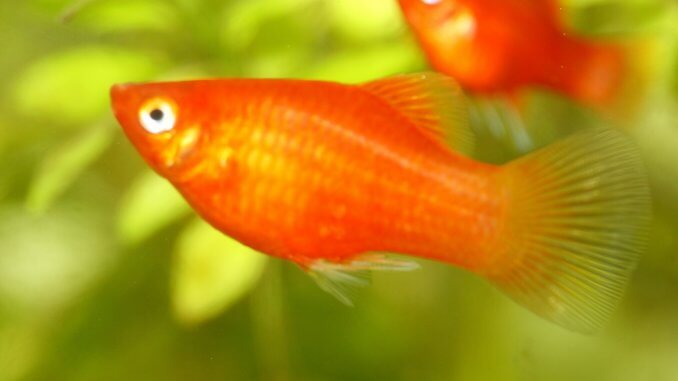
Platy fish are freshwater fish that belong to the Poeciliidae family. They are often referred to as platies or southern platy fish.
Platy fish are easy to care for, docile, and popular among aquarists because of their vibrant coloration. There are several different types of platy fish.
TABLE OF CONTENTS
Platy Fish Facts & Overview
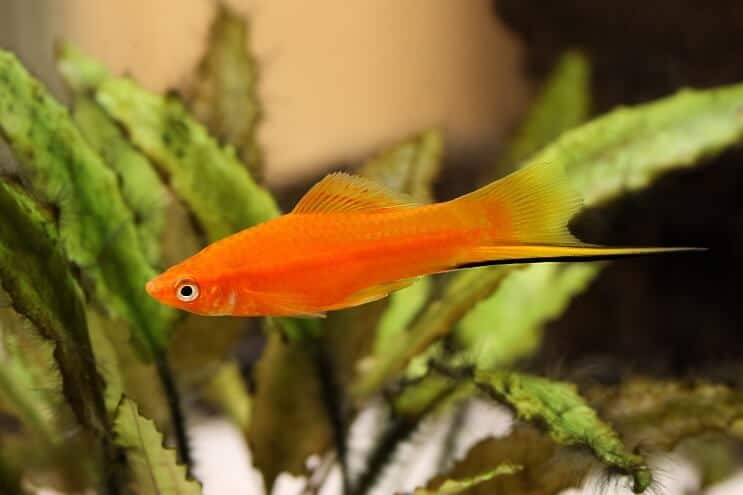
| Genus name: | Xiphophorus |
| Common names: | Platy fish, platyfish, platies, southern platy, variable platy, swordtail platy, common platy, spike tail platy |
| Distribution: | Central America, Mexico |
| Size: | Up to 3 inches |
| Life expectancy: | 2–3 years |
| Color: | Varies |
| Diet: | Omnivore |
| Temperament: | Peaceful |
| Minimum tank size: | 10 gallons |
| Temperature: | 70–77°F (21–25°C) |
| pH: | 6.8–8.0 |
| Hardness: | 10–28 dGH |
| Care level: | Easy |
| Breeding: | Livebearers |
Origin
Platy fish are native to Central America and Mexico. The two most common species of platy fish in the pet trade are the southern platy fish (Xiphophorus maculatus) and variable platy fish (Xiphophorus variatus).
These platies are often crossbred with each other or with swordtail species. Several selectively-bred variable and southern platy varieties exist, including the wagtail, tuxedo, comet, and rainbow platy. Wild platy fish are less colorful than the platies found in the pet trade today.
Both species are prolific in the wild and popular among aquarists. While the International Union for Conservation of Nature (IUCN) doesn’t have recorded data of the southern platy, the variable platy fish is classified as a “least-concern species.”
Adult Size & Lifespan
A platy fish’s size varies depending on sex, environment, and species. Male platy fish have an average size of two inches, while female platy fish reach up to three inches in length. Variable platy fish are slightly larger than southern platy fish.
Captive platy fish have an average lifespan of two to three years. In the wild, platy fish live longer. Proper care and ideal tank conditions allow these fish to thrive.
Availability
Platy fish are affordable and widely available in online stores and local pet stores. Platy fish cost between $3 to $6 each. However, price can vary depending on the variety of platy fish.
Some varieties, such as the tiger ruby platy, can cost up to $9 each. The swordtail platy (Xiphophorus xiphidium) is rare in the pet trade and difficult to obtain.
Platy fish do best in groups of six. A group of this size costs around $30. Reputable online stores that stock platy fish include Arizona Aquatic Gardens, LiveAquaria, and Aquatic Arts. Buy fish that are active with bright eyes and healthy coloration.
Appearance & Behavior
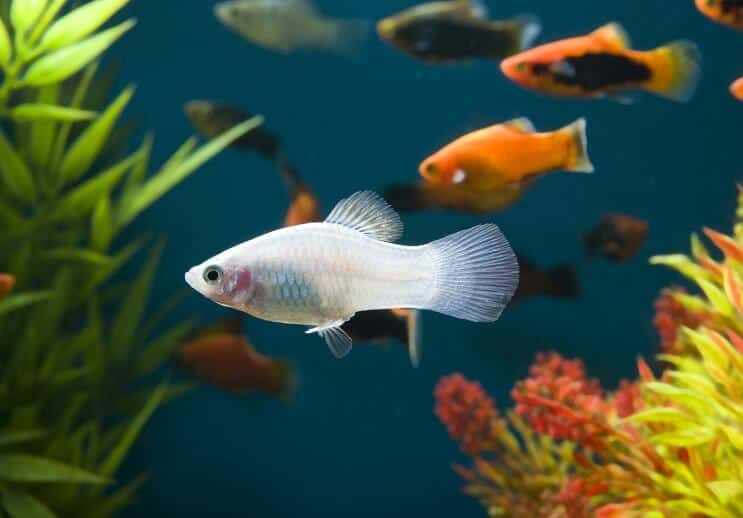
Platy fish come in a wide range of patterns and colors. Most platy fish are peaceful and get along well with fish that have similar temperaments.
Colors, Patterns, Fins, and Sex Differences
Platy fish have flattened, short bodies with fan-shaped tails and triangular heads. Platy fish are sexually dimorphic. Males are smaller than females and have a gonopodium. They become dull when stressed or sick.
There are several varieties of platy fish, each having its own unique qualities. Wild platy fish lack the coloration of their captive-bred counterparts. Popular varieties include:
- Comet platy fish: Also known as twin bar platy. Comes in several colors, with orange and yellow being the most common. Its tail has black stripes at the top and bottom.
- Gold red platy fish: Front half of its body is yellow, but the color gradually changes to a deep red, with a gradient sunset look. Fins are black or translucent. Yellow and red are the most popular color combination, but selective breeding has introduced blue and green variations.
- Hifin platy fish: Elongated dorsal fin that curves over the back. Found in a variety of patterns and colors.
- Mickey Mouse platy fish: Gets its name from the Mickey Mouse-shaped marking near its tail. Comes in several hues, but this variety is difficult to obtain.
- Pintail platy fish: The middle of its tail is elongated and pin-like. Less common than the hifin variety.
- Rainbow platy fish: Iridescent and colorful, with a rainbow-like appearance and black tail. Comes in dark tones and light tones.
- Red coral platy fish: Vibrant red coloration. Its body, fins, and tail are all red.
- Salt and Pepper: Black spots scattered all over its body. The pattern hue is always black, but primary body coloration varies.
- Tuxedo platy fish: Has a black patch in the center of its body that makes the fish look like it’s wearing a tuxedo. Variety of colors available.
Typical Behavior
Platy fish are peaceful, social, and get along well with other fish. While not considered a schooling species, platy fish become more confident in groups of six. These fish are active and stay at the middle and top levels of the tank. Platy fish enjoy exploring and hiding among plants.
Platy fish are rarely aggressive, but males often pester females and can show aggression to other males during breeding. Prevent aggression by ensuring females outnumber males in the tank. These fish are diurnal, meaning they’re active during the day and rest at night.
Platy Fish Care & Tank Requirements
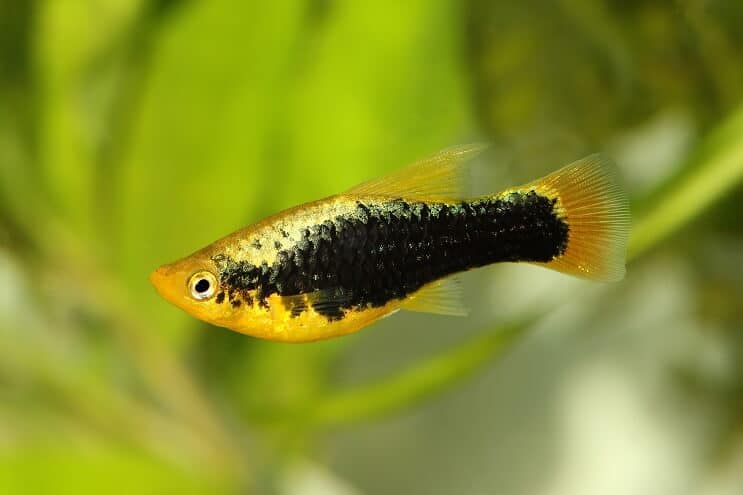
Platy fish are easy to care for because these fish are hardy and can tolerate most tank conditions. They do best in the company of their own kind and require a tank that simulates their natural habitat.
Platy fish are omnivores and should be fed a varied diet of frozen and live foods, pellets, flakes, and vegetables.
Habitat and Tank Requirements
In the wild, platy fish inhabit peripheral waters such as ditches, backwaters, swamps, and ponds. These warm bodies of water are slow-moving, moderately hard, and densely vegetated.
Platy fish are hardy and can adapt to a wide range of water conditions, but a biotope tank helps platy fish thrive and live long lives in captivity.
Tank Conditions
The ideal tank conditions for platy fish include the following:
| Water type: | Freshwater, with 25%–30% water changes every two weeks |
| Tank size: | Minimum 10 gallons for a group of five to six platy fish. Increase by 2 gallons per additional fish. Platy fish are active swimmers and require a spacious, elongated tank |
| Water temperature: | 70–77°F (21–25°C) |
| Substrate: | Any substrate is suitable. Platy fish aren’t picky over substrate because these fish rarely swim at the bottom. A dark-hued sandy substrate helps show off a platy fish’s colors |
| Tank setup: | Tank should contain plants and lots of open space for platy fish to swim and release their energy. Platy fish can jump out of the tank, so a secure tank lid is essential |
| Acidity: | Platy fish prefer water on the alkaline side. Stick to a pH level between 6.8 and 8.0 |
| Water hardness: | Opt for a hardness between 10–28 dGH. Platy fish are used to hard water in the wild |
| Filter: | Filtration keeps the tank clean and ammonia and nitrate levels low. Avoid filtration systems that cause strong currents. Platy fish are accustomed to slow-moving water |
| Bubbler: | Not needed as long as tank is spacious |
| Lighting: | Moderate lighting during the day. Keep lighting dim at night to replicate a day-to-night cycle. Avoid harsh lighting |
| Plants: | Plants provide hiding spots and help platy fish feel at home Plants should be hardy and able to tolerate similar water conditions. Ideal plants include hornwort, duckweed, and java moss. Floating plants work well because platy fish prefer to swim at the surface |
Create the ideal environment with plants, a gentle filtration system, and clean water with moderate hardness.
The swordtail platy fish isn’t as hardy as other platy species, and requires additional care. Water must always be kept stable and within ideal parameters. Perform water changes more regularly, with a partial 25% water change every week.
Disease
Platy fish are hardy and aren’t prone to any particular disease. However, common freshwater diseases that affect platy fish in captivity include fin rot, Ich, and velvet.
Fin rot
Fin rot is a disease caused by stress or poor-quality water conditions. Long-finned varieties of platy fish, such as the hifin platy and pintail platy, are more prone to fin rot than other platies. Symptoms include ragged, tattered fins and changes in fin coloration.
Treat fin rot with regular water changes and antibiotics.
Ich
Ich is a disease caused by the protozoan Ichthyophthirius multifiliis. Fish with Ich develop white, salt-like spots on their body, fins, and gills. Other symptoms include lethargy and flashing behavior. Flashing is when the fish rubs against rough structures.
Quarantine infected fish in a separate tank, and raise the temperature by two to three degrees. Treat Ich by adding a tablespoon of salt for every five gallons of water.
Velvet
Velvet is a disease caused by the parasite Öodinium. The parasite affects the body, causing rust-colored cysts to form. The main symptoms are unusual swimming patterns, flashing, and lethargy.
Treat velvet by quarantining the fish, keeping lighting dim, and adding copper sulfate to the tank.
Tank Mates
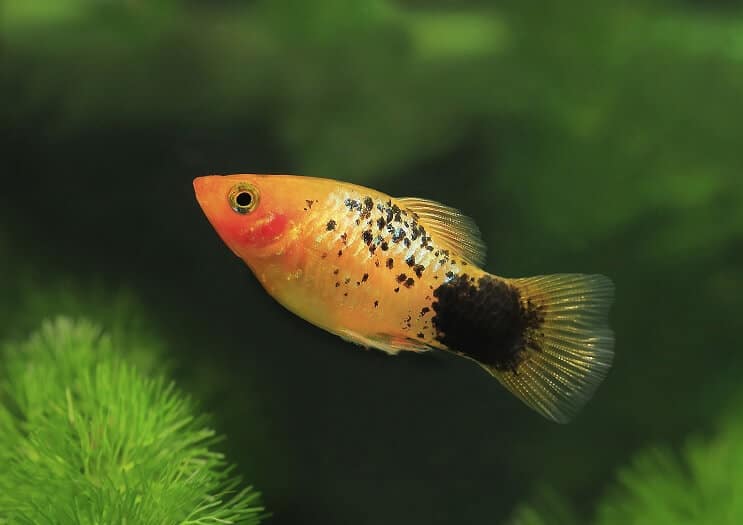
Platy fish are peaceful and aren’t aggressive toward other fish, but there needs to be more females than males in the tank. Keep one male for every three female platy fish. Platy fish shouldn’t be housed with aggressive or fast-moving fish like bettas.
The best tank mates for platy fish are peaceful, similar-sized species that won’t disturb the platy fish. These include:
Long-finned platy varieties shouldn’t be kept with renowned fin-nippers, such as tiger barbs and tetras.
Diet and Feeding
Platy fish are omnivores. In the wild, platy fish eat algae, plant matter, small crustaceans, and insects. A vitamin-rich diet improves coloration in platy fish.
Platies aren’t picky, but they do best on a diet mainly consisting of quality flake food and vegetables. Ideal vegetables include spinach, cucumber, and lettuce. Occasionally feed live and frozen foods such as tubifex, brine shrimp, and bloodworms. Platies graze on algae within the tank.
Only give platy fish an amount they can eat within three minutes. Feed adult platy fish once or twice daily. Juvenile platy fish must be fed several times a day.
Breeding
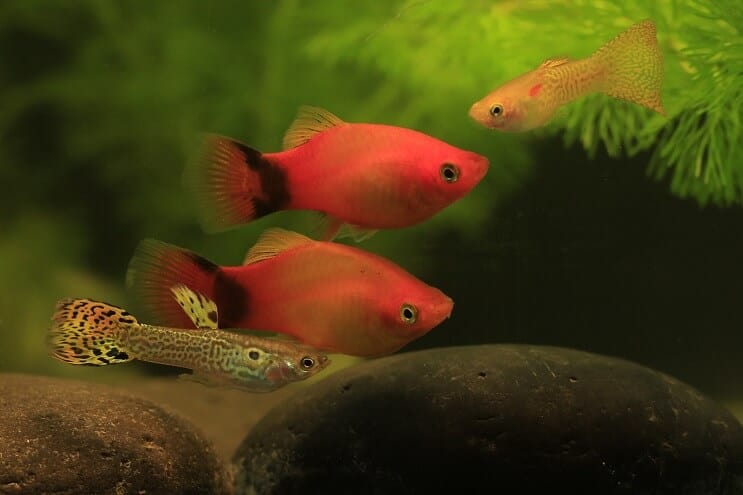
Platy fish are livebearers and are easy to breed. These fish breed readily when in ideal tank conditions. Platy fish can breed within a large community tank, as long as there’s dense vegetation or a breeding trap to protect the fry.
Setting up a separate tank for the female platy fish to give birth ensures the fry stay safe and unharmed.
Females produce new broods monthly. A gravid female (carrying eggs) is plump and sometimes develops a visible black spot on her body, known as a gravid spot.
- Set up a 10–20 gallon breeding tank with stable water parameters, dense planting, and a gentle filter. Cover the filter with a sponge to prevent the fry from being sucked up.
- Once the female platy fish is gravid, put her into the breeding tank.
- Gestation can take between four and six weeks, and female platy fish produce up to 80 fry.
- Return the female to her home tank after she has finished giving birth.
- Fry are large enough to be fed powdered flake and baby brine shrimp immediately. Feed platy fish fry three times daily to support healthy growth.
Should You Get a Platy Fish for Your Aquarium?
Platy fish are docile, hardy fish that make wonderful additions to community tanks. You should get platy fish if you have a spacious tank that’s densely vegetated, with moderately hard, alkaline water.
Tank mates must be peaceful and similar in size to platy fish. Long-finned platy fish varieties shouldn’t be kept with fin-nippers. Platy fish thrive with appropriate care and bring a splash of color to any tank.
Platy Fish FAQs
- Can cherry shrimp live with platies?
- How many platies can I put in a 10-gallon tank?
- What do platies need in their tank?
- Do platy fish lay eggs?
- Can platies and mollies live together?
- Are platies cold water fish?
- Do platies need air pumps?
- Can platies live with guppies?
- Are platy fish smart?
- Are platy fish easy to keep?
- Do platies eat their babies?
- How much do platy fish cost?
- Do platies need a filter?
- Are platies hardy?
- Are platies schooling fish?
- Can platies be kept with bettas?
- How long do platy fish live for?
- Are platies aggressive?
- How big do platies get?
- How many platies should be kept together?

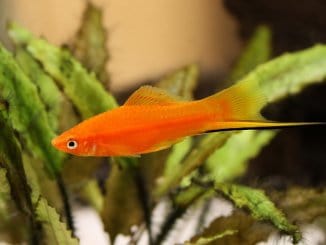
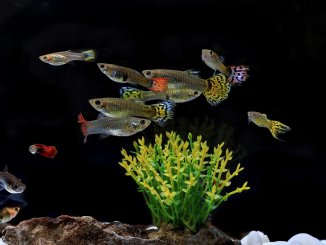
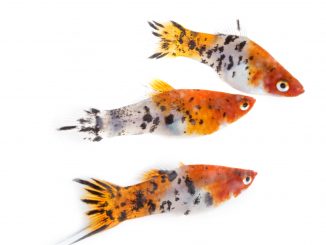
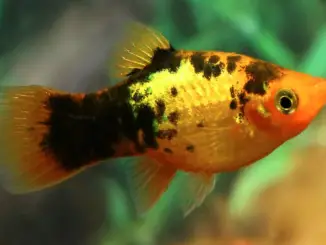
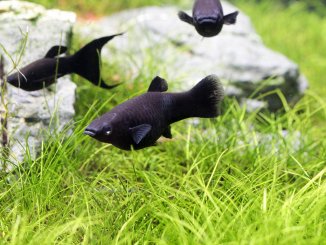
Good information given here. But now I have questions, I am a bit wary of how easily they breed, I hadn’t planned on “saving” fry ( from cannibalism) in a different smaller tank. And how would one feed fry egg yolk? Boiled yolk? Would it be easier to relocate a pregnant mom before she bears fry. Will the mother eat her own fry? I’m thinking I may take the males back to exchange for all females. Is this okay? Will they cross breed with other platies.
Here’s my set up:I don’t have live plants in my 50 gallon tank. I have a large variety of silk and soft ( non pointy) artificial plants, rounded mounds of river rock with hiding spaces, cave like decorations and aquarium gravel on the bottom. Extra mild river like currents are provided for aeration. A bubble wand provides lots of tiny bubbles the length of the tank. Is my tank suitable for the 5 orange common and 2 larger whitish with yellow sheen platies?
Hi Patti, thanks for your message. Platies are likely to eat their own fry so the mother should be separated from from the breeding tank when shes given birth. It will be down to the store you bought them from as to whether they are happy to take the fish back in exchange for females. The setup sounds great for a community tank, if you want to achieve a breeding tank you’ll need less current. Many thanks, Robert
Yolk?
I just set up my tank but it’s only 5.5 gallons. Maybe I should up size to a 10 g tank? It looks like my platties are already pregnant. I got them from my little sister. Her tank leaked out so rescued them. I just added one of those horn plants. Looks like I have 3 females and a male adult . And two generations of babies, one small and two very small. They also have two catfish tank mates. The platties are reddish orange with black tail fins. I have an adjustable flow filter and a thermometer . They have about an inch of gravel. Any extra tips or info would be cool. Thinking about getting a heater but they are near the vent to the house heater. Not sure exactly what kind they are . It’s been years since I kept fish . Very excited .
I have a 400 gallon tank with few plants and areas that have Swift current. My platys seem happy enough. They breed constantly. I do nothing to stop them from eating 5heir fry. I do nothing to feed their fry. However the fry seem to manage quite well. Many of them end up down in my Refugio’s where it is safer. They simply get 5here along with the water! The ones in the Refugio’s have java moss and I don’t feed 5hem at all. They only get what spills over the overflow. What I am trying to say… is they have so many babies that some of them manage to always make it. Sad to say but my husband has an cichid tank with 2 Oscars. He harvests some of the many babies to feed them. We simply couldn’t keep them all!
HI there, I have been fish keeping for decades, mostly live bearers. I have been successful in rearing many fish but not so much with Platies. I am able to keep small fry healthy (have a small tank, as well as in my community tank that has lots of vegetation), however as they reach a certain juvenile age/size they appear to get some sort of sores anywhere on their body and die. I have no other diseases in my tank. I am desperate and wondering if you can help
Hi there. I have 7 sunburst platys in a 29 gallon tank. 1 little algae eater. That’s it. Temperature is 78 degrees. Not sure how many females/males I have. So, 1st question: is the tank too warm? 2nd question: my female/male ratio…..how can I figure that out? Thanks.
So my son’s platy has had 3 babies but is still very pregnant, not swimming but is eating. She’s been on the bottom about 2 weeks. She’s had 2 salt baths she can swim she just “sits” on the bottom. What do we need to do?
Hi, I have a 12″L*6″W*9″T aquarium. Kept 1 male and 3 female platies. One have them is heavily pregnant and already started giving birth as well as eating the fries. So I plan to separate the pregnant platy in another 10 liters container and once she gives birth, then relocate her to the main aquarium. Will it work?
Hello, thank you for the informative article.
I am worried that I will have too many fish in my tank soon as Platys are having lots of babies.
My 55 Gallon setup consists of 4 Platys, 15 Harleqin Rasboras, 2 Ancistrus and 3 Algae Eater.
I already have 5 babies who managed to survive by hiding in the rift woods I have.
Its super cute to have baby fish yet I do not want to overstock my tank or breed family members with each other :-/
Do you think my newly added Rasboras shoal will eat some of the future fry?!
thank you so much in advance!
My husband cleaned our tank out .now our platys stay low at the back of the tank .we have kept fish for years and this has never happened before. They were fine before the clean out .neons and catfish are fine .
I have 3 variable platys two black and orange and one orange. I don’t there ages but I was told that they’re all male only had them a week.